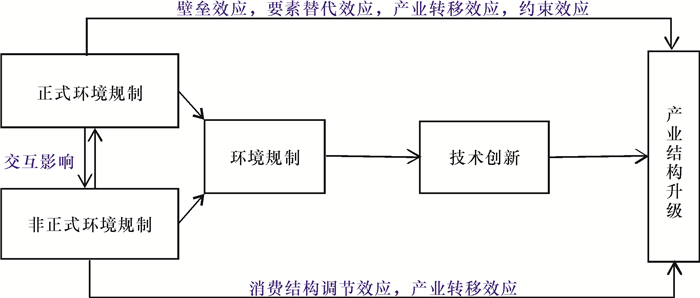Coordination of Environmental Regulation, Technological Innovation and Upgrading of Industrial Structure in Urban Agglomerations: Based on the Empirical Analysis of 10 Urban Agglomerations in China
-
摘要: 基于中国十大城市群2003-2018年的面板数据,借助动态中介效应模型、面板门槛回归技术等研究环境规制、技术创新与产业结构升级的关系。结果显示:(1)十大城市群整体和分区域的样本检验表明, 正式环境规制和非正式环境规制均对产业结构升级具有正向影响,但二者的协同效应并不明显。(2)不同类型环境规制对城市群产业结构升级的影响均能通过技术创新体现出显著中介效应。(3)以技术创新为门槛变量,正式环境规制及正式与非正式环境规制的协同作用均与城市群产业结构升级呈U型关系,而非正式环境规制与城市群产业结构升级呈折线对应关系;受技术创新水平的影响,环境规制对城市群产业结构升级的作用存在区域和时间段异质性。当前应把握好正式环境规制的力度和方式,让非正式环境规制的实施做到循序渐进和差别化,以技术创新为核心力量,以环境治理和产业结构升级为重要抓手,使城市群的高质量发展过程能保持政策的协调性、有效性和可持续性。Abstract: This paper attempts to comprehensively investigate the relationship between environmental regulation, technological innovation and upgrading of industrial structure with the help of dynamic mediating effect model and panel threshold regression technology based on the panel data of China's top ten urban agglomerations from 2003 to 2018. The conclusions are as follows: the sample analysis of the whole and sub-regions oftop ten urban agglomerations show thatformal environmental regulation and informal environmental regulationare both conducive to the upgrading of industrial structure, but the synergetic effect is not significant; the influence of different types of environmental regulation on the upgrading of industrial structure all presents significant intermediary effects through technological innovation; technological innovation is used as the threshold variable, formal environmental regulation, synergetic effect of formalenvironmentalregulation and informal environmental regulation withupgrading of industrial structure have a "U" type relationship, while informal environmental regulation and upgrading of industrial structure has a broken line corresponding relationship. The effect of environmental regulation on the upgrading of industrial structure in urban agglomerations has regional and temporal heterogeneity affected by the level of technological innovation. Finally, the paper puts forward the corresponding policy suggestions from four perspectives: formal environmental regulation, informal environmental regulation, technological innovation and policy system.
-
表 1 中国十大城市群及其所包含城市
所属区域 城市群 包含城市 东部城市群 京津冀城市群 北京、天津、石家庄、唐山、秦皇岛、保定、张家口、承德、沧州、廊坊、邢台、邯郸、衡水 辽中南城市群 沈阳、大连、鞍山、抚顺、本溪、丹东、辽阳、营口、盘锦、铁岭、锦州、阜新、葫芦岛 长江三角洲城市群 上海、南京、无锡、常州、苏州、南通、扬州、镇江、泰州、杭州、宁波、嘉兴、湖州、绍兴、舟山、台州、盐城、金华 海峡西岸城市群 福州、厦门、漳州、泉州、莆田、宁德、龙岩、三明、南平、温州、丽水、衢州、汕头、梅州、衢州、揭阳 山东半岛城市群 济南、青岛、烟台、潍坊、淄博、东营、威海、日照 珠江三角洲城市群 广州、深圳、珠海、佛山、江门、肇庆、惠州、东莞、中山 中西部城市群 中原城市群 郑州、洛阳、开封、新乡、焦作、许昌、平顶山、漯河 长江中游城市群 武汉、黄石、鄂州、黄冈、孝感、咸宁、荆门、荆州、九江、岳阳、襄阳、宜昌、长沙、常德、益阳、株洲、湘潭、德阳、娄底、南昌、景德镇、鹰潭、上饶、新余、抚州、宜春、萍乡 成渝城市群 重庆、成都、自贡、泸州、德阳、绵阳、遂宁、内江、乐山、南充、眉山、宜宾、雅安、资阳 关中城市群 西安、咸阳、宝鸡、渭南、铜川、商洛 注:十大城市群包括东部六大城市群77个城市、中西部四大城市群55个城市,共计132个城市。 表 2 样本均值的描述性统计
变量 全部城市群 东部 中西部 2003-2009 2010-2018 structure 0.685 7 0.717 3 0.655 6 0.726 0 0.654 4 fer 0.528 6 0.557 4 0.488 4 0.163 3 0.812 8 zfer 0.000 3 0.000 3 0.000 2 0.000 2 0.000 3 fer×zfer 0.000 2 0.000 2 0.000 1 0.000 1 0.000 3 lnpatent 7.346 1 7.889 8 6.584 8 6.405 8 8.077 4 agdp 3.758 0 4.935 2 2.109 9 2.642 2 4.625 8 fixasset 0.521 8 0.387 2 0.710 3 0.420 0 0.601 0 fdi 0.033 1 0.037 6 0.026 9 0.036 1 0.030 8 表 3 环境规制对城市群产业结构升级的直接影响(全部城市群样本)
变量 (1) (2) (3) L.structure 0.9250*** (126.96) 0.9240*** (127.85) 0.9240*** (127.13) fer 0.0015***(4.16) 0.0027*(2.44) zfer 68.7500*** (6.80) 66.6000*** (6.39) fer×zfer -3.6540 (-1.49) lnpatent 0.0122***(19.62) 0.0086*** (10.04) 0.0083*** (9.51) agdp 0.0013*** (5.13) 0.0009*** (3.44) 0.0009** (3.20) fixasset -0.0088***(-5.37) -0.0084*** (-5.34) -0.0067*** (-4.02) fdi 0.0165 (0.66) 0.0192 (0.77) 0.0163 (0.66) _cons -0.0465*** (-5.47) -0.0370*** (-4.30) -0.0353** (-4.08) N 2 112 2 112 2 112 注:括号中为t值;*、**、***分别表示在10%、5%和1%水平下显著。表 4至表 6同。 表 4 环境规制对城市群产业结构升级的直接影响(分区域城市群样本)
变量 东部城市群 中西部城市群 (1) (2) (3) (1) (2) (3) L.structure 0.941 0***
(83.57)0.940 0***
(84.54)0.938 0***
(83.56)0.913 0***
(73.74)0.923 0***
(72.78)0.922 0***
(72.95)fer 0.0011**
(2.76)0.002 0*
(1.56)0.003 0**
(3.10)0.004 9*
(2.05)zfer 67.440 0***
(5.18)65.950 0***
(4.94)67.450 0***
(3.68)61.540 0**
(3.25)fer×zfer -2.682
(-0.95)-6.436 0
(-1.17)lnpatent 0.0129***
(16.34)0.008 8***
(7.54)0.008 6***
(7.34)0.008 5***
(6.13)0.007 6***
(5.28)0.006 8***
(4.60)agdp 0.001 2***
(4.33)0.000 8**
(2.92)0.000 8**
(2.73)0.003 5**
(2.94)0.002 7*
(2.13)0.002 2
(1.72)fixasset 0.0019
(0.57)0.003 7
(1.11)0.004 5
(1.35)-0.009 2***
(-4.17)-0.011 6***
(-6.55)-0.008 2***
(-3.68)fdi -0.008 7
(-0.27)-0.012 1
(-0.38)-0.011 5
(-0.36)0.022 7
(0.51)0.016 6
(0.37)0.015 5
(0.35)_cons -0.068 5***
(-6.02)-0.053 7***
(-4.56)-0.051 3***
(-4.30)-0.0168
(-1.11)-0.028 6
(-1.87)-0.024 8
(-1.61)N 1 232 1 232 1 232 880 880 880 表 5 正式环境规制、非正式环境规制与城市群产业结构升级的中介效应回归结果
变量 (4) structure (5) lnpatent (6) structure (7) structure (8) lnpatent (9) structure L.struture 1.605 0***
(25.58)1.529 0***
(22.08)1.549 0***
(21.82)1.517 0***
(21.28)fer 0.001 6*
(2.01)-0.094 1***
(-3.49)0.001 5*
(1.70)zfer 97.030 0***
(9.37)-2 049.3***
(-7.08)52.280 0***
(4.16)lnpatent 0.009 8***
(8.32)0.007 2***
(5.97)L.lnpatent 0.864 0***
(18.48)0.830 0***
(15.47)agdp -0.001 2
(-1.10)0.005 5
(0.63)-0.004 4*
(-2.07)-0.002 5*
(-2.15)0.056 0**
(3.25)-0.003 7*
(-2.51)fixasset 0.012 0***
(5.06)-0.101 0*
(-1.98)0.006 5**
(2.87)0.007 6***
(3.54)0.022 6
(0.54)0.004 5*
(2.02)fdi -0.673 0***
(-4.13)-1.751 0
(-0.68)-0.4330**
(-3.25)-0.508 0***
(-3.66)-4.102 0
(-1.72)-0.378 0**
(-2.85)_cons -0.017 0*
(-2.55)0.422 0***
(5.70)-0.091 1***
(-7.68)-0.033 3***
(-5.36)0.722 0***
(4.93)-0.078 3***
(-6.76)N 2 112 2 112 2 112 2 112 2 112 2 112 表 6 正式与非正式环境规制的协同作用对城市群产业结构升级的中介效应回归结果
变量 (10) structure (11) lnpatent (12) structure L.structure 1.521 0***(22.84) 1.502 0***(22.28) fer 0.004 7*(2.03) -0.332 0*(-2.54) 0.005 9*(2.12) zfer 92.440 0***(8.22) -1 036.900 00***(-3.30) 33.810 0*(2.36) fer×zfer -10.830 0*(-2.19) 447.500 0*(1.85) -10.890 0*(-1.93) lnpatent 0.008 1***(6.26) L.lnpatent 0.8610***(17.88) agdp -0.004 7(-1.91) -0.012 5(-0.87) -0.003 2*(-2.32) fixasset 0.001 9(0.83) -0.242 0**(-3.23) 0.004 4(1.70) fdi -0.196 0***(-4.03) 1.207 0(1.44) -0.186 0***(-4.04) _cons -0.021 4***(-3.39) 0.028 3***(3.16) -0.035 3***(-5.08) N 2 112 2 112 2 112 表 7 十大城市群门槛效应检验结果
核心解释变量 门槛阶数 门槛值 F值 P值 10%的临界水平 5%的临界水平 1%的临界水平 fer 一阶门槛 7.567 9 63.46 0.004 0 28.961 6 35.222 8 50.304 9 zfer 一阶门槛 5.010 6 169.30 0.000 0 44.179 4 52.468 7 71.746 4 zfer 二阶门槛 5.638 4 40.64 0.036 0 30.052 8 36.991 9 45.926 8 fer×zfer 一阶门槛 7.567 9 79.16 0.010 0 27.685 0 35.322 8 68.119 3 表 8 面板门槛回归参数估计结果(以技术创新为门槛变量)
变量 核心解释变量fer 核心解释变量zfer 核心解释变量fer×zfer fer (2.23) 0.0027* zfer 201.900 0***
(-8.75)fer(lnpatent≦7.567 9) -0.019 9***
(-6.56)fer(lnpatent>7.567 9) 0.003 9**
(3.03)zfer(lnpatent≦5.010 6) -130.400 0***
(-5.64)zfer(5.010 6 < lnpatent≦5.638 4) 155.600 0***
(3.70)zfer(lnpatent>5.638 4) 640.200 0***
(9.51)fer×zfer(lnpatent≦7.567 9) -68.314 5***
(-8.15)fer×zfer(lnpatent>7.567 9) 5.405 9*
(1.99)agdp -0.003 4***
(-3.79)-0.003 8***
(-4.42)-0.007 5***
(-9.56)fixasset -0.132 0***
(-27.00)-0.103 0***
(-21.24)-0.135 0***
(-27.57)fdi -0.213 0**
(-2.76)-0.243 0**
(-3.27)-0.123 3
(-1.58)_cons 0.832 0***
(128.71)0.786 0***
(111.25)0.790 8***
(168.69)N 2 112 2 112 2 112 -
[1] 张小筠, 刘戒骄, 李斌. 环境规制、技术创新与制造业绿色发展[J]. 广东财经大学学报, 2020(5): 48-57. https://www.cnki.com.cn/Article/CJFDTOTAL-SONG202005005.htm [2] 王灿, 张雅欣. 碳中和愿景的实现路径与政策体系[J]. 中国环境管理, 2020(6): 58-64. https://kns.cnki.net/KCMS/detail/detail.aspx?dbcode=CJFD&filename=ZHGL202006012 [3] 周海华, 王双龙. 正式与非正式的环境规制对企业绿色创新的影响机制研究[J]. 软科学, 2016(8): 47-51. https://www.cnki.com.cn/Article/CJFDTOTAL-XUXI201608011.htm [4] 余东华, 崔岩. 双重环境规制、技术创新与制造业转型升级[J]. 财贸研究, 2019(7): 15-24. https://www.cnki.com.cn/Article/CJFDTOTAL-CMYJ201907002.htm [5] 李文静. "十四五"时期中国城市群高质量发展的思路与策略[J]. 学术研究, 2021(1): 90-96. [6] 吴福象, 沈浩平. 新型城镇化、创新要素空间集聚与城市群产业发展[J]. 中南财经政法大学学报, 2013(4): 36-42. doi: 10.3969/j.issn.1003-5230.2013.04.005 [7] 刘世锦. 中国经济增长十年展望(2020-2029): 战役增长模式[M]. 北京: 中信出版社, 2020. [8] GRAY W B, SHADBEGIAN R J. Plant vintage, technologyand environmental regulation[J]. Journal of Environmental Economics and Management, 2003, 46(3): 384-402. doi: 10.1016/S0095-0696(03)00031-7 [9] 王凯. 环境规制对我国工业行业出口竞争力的影响——以污染密集型行业为例[J]. 价格理论与实践, 2012(1): 80-81. https://www.cnki.com.cn/Article/CJFDTOTAL-JGLS201201040.htm [10] ZHAO X, SUN B. The influence of Chinese environmental regulation on corporation innovation and competitivenss[J]. Journal of Cleaner Production, 2016, 112(4): 1528-1536. http://www.sciencedirect.com/science/article/pii/S0959652615005752 [11] PORTER MICHAEL E, VANDER LINDE C. Toward a new conception of the environmental-competitiveness relationship[J]. Journal of Economic Perspectivest, 1995, 9(4): 97-118. doi: 10.1257/jep.9.4.97 [12] 薛曜祖. 环境规制的产业结构效应: 理论与实证分析[J]. 统计与信息论坛, 2016(8): 39-45. doi: 10.3969/j.issn.1007-3116.2016.08.008 [13] 李强. 环境规制与产业结构升级——基于Baumol模型的理论分析与实证研究[J]. 经济评论, 2013(5): 100-107. https://www.cnki.com.cn/Article/CJFDTOTAL-JJPL201305011.htm [14] 徐开军, 原毅军. 环境规制与产业结构升级的实证研究——基于不同污染物治理视角下的系统GMM估计[J]. 工业技术经济, 2014(12): 101-109. doi: 10.3969/j.issn.1004-910X.2014.12.014 [15] 钟茂初, 李梦洁, 杜威剑. 环境规制能否倒逼产业结构升级——基于中国省际面板数据的实证检验[J]. 中国人口·资源与环境, 2015(8): 107-115. doi: 10.3969/j.issn.1002-2104.2015.08.014 [16] 董直庆, 王辉. 环境规制的"本地-邻地"绿色技术进步效应[J]. 中国工业经济, 2019(1): 100-118. https://www.cnki.com.cn/Article/CJFDTOTAL-GGYY201901009.htm [17] 郑加梅. 环境规制产业结构调整效应与作用机制分析[J]. 财贸研究, 2018(3): 21-29. https://www.cnki.com.cn/Article/CJFDTOTAL-CMYJ201803003.htm [18] 毛建辉, 管超. 环境规制、政府行为与产业结构升级[J]. 北京理工大学学报: 社会科学版, 2019(3): 1-10. https://www.cnki.com.cn/Article/CJFDTOTAL-BLDS201903001.htm [19] 梅国平, 龚海林. 环境规制对产业结构变迁的影响机制研究[J]. 经济经纬, 2013(2): 72-76. doi: 10.3969/j.issn.1006-1096.2013.02.014 [20] 时乐乐, 赵军. 环境规制、技术创新与产业结构升级[J]. 科研管理, 2018(1): 120-125. https://www.cnki.com.cn/Article/CJFDTOTAL-KYGL201801013.htm [21] 殷宇飞, 杨雪锋. 环境规制、技术创新与城市产业结构升级——基于113个城市样本数据[J]. 江汉论坛, 2020(4): 48-55. doi: 10.3969/j.issn.1003-854X.2020.04.007 [22] 王双燕, 魏晓平, 赵雷英. 外商直接投资、环境规制与产业结构高级化[J]. 首都经济贸易大学学报, 2016(1): 26-32. https://www.cnki.com.cn/Article/CJFDTOTAL-SDJM201601004.htm [23] 童健, 刘伟, 薛景. 环境规制、要素投入结构与工业行业转型升级[J]. 经济研究, 2016(7): 43-57. https://www.cnki.com.cn/Article/CJFDTOTAL-JJYJ201607005.htm [24] PORTER G. Global environmental politics[M]. New York: Westview Press, 1991. [25] 曾鹏, 禇王安, 张晓君. 就业结构、文化教育和城市规模对城镇化质量的影响——基于中国十大城市群的经验分析[J]. 统计与信息论坛, 2015(11): 72-76. doi: 10.3969/j.issn.1007-3116.2015.11.012 [26] 赵娜, 王博, 刘燕. 城市群、聚集效应与"投资潮涌"——基于中国20个城市群的实证研究[J]. 中国工业经济, 2017(11): 81-99. https://www.cnki.com.cn/Article/CJFDTOTAL-GGYY201711005.htm [27] 干春晖, 郑若谷, 余典范. 中国产业结构变迁对经济增长和波动的影响[J]. 经济研究, 2011(5): 4-16. https://www.cnki.com.cn/Article/CJFDTOTAL-JJYJ201105002.htm [28] SMARZYNSKA B K, SHANG-JIN WEI. Pollution havens and foreign direct investment: dirty secret or popular myth[J]. Cepr Discussion Paper, 2001, 3(2): 2966-2997. http://papers.ssrn.com/sol3/papers.cfm?abstract_id=285524& [29] PARGAL S, WHEELER D. Informal regulation of industrial pollution in developing countries: evidence from Indonesia[J]. Journal of Political Economy, 1996, 104(6): 1314-1327. doi: 10.1086/262061 [30] 刘胜, 李文秀, 陈秀英. 生产性服务业与制造业协同集聚对企业创新的影响[J]. 广东财经大学学报, 2019(3): 43-53. https://www.cnki.com.cn/Article/CJFDTOTAL-SONG201903009.htm [31] 原毅军, 谢荣辉. 环境规制的产业结构升级效应研究——基于中国省际面板数据的实证检验[J]. 中国工业经济, 2014(8): 59-61. https://www.cnki.com.cn/Article/CJFDTOTAL-GGYY201408006.htm [32] HANSEN B E. The grid bootstrap and the autoregressive model[J]. The Review of Economics and Statistics, 1999, 81(4): 594-607. doi: 10.1162/003465399558463 -





 下载:
下载:

